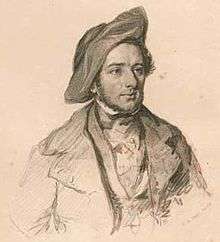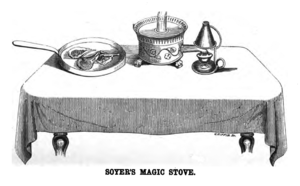Alexis Soyer
| Alexis Soyer | |
|---|---|
 Alexis Soyer in 1849 | |
| Born |
4 February 1810 Meaux-en-Brie, France |
| Died |
5 August 1858 (aged 48) England |
| Occupation | Chef |
| Works | Soyer stove |
Alexis Benoit Soyer (4 February 1810 – 5 August 1858) was a French chef who became the most celebrated cook in Victorian England. He also tried to alleviate suffering of the Irish poor in the Great Irish Famine (1845–1849), and contributed a penny for the relief of the poor for every copy sold of his pamphlet The Poor Man's Regenerator (1847). He worked to improve the food provided to British soldiers in the Crimean War. A variant of the field stove he invented at that time, known as the "Soyer stove", remained in use with the British army until 1982.[1][2]
Biography
Alexis Benoist Soyer was born at Meaux-en-Brie in France. His father had several jobs, one of them as a grocer. At the age of nine he was sent by his parents to the cathedral church as they had decided on his becoming a priest. Soyer resented the career path chosen for him and contrived his dismissal whereupon a year later, in 1821, he was sent to Paris where he lived with his elder brother Phillipe.[3] He became an apprentice at the Grignon restaurant in Paris. Later, in 1826 he moved to Boulevard des Italiens restaurant, where he became a chief cook. By 1830, Soyer was a second cook to Prince Polignac, the French prime minister.
On 26 July 1830, while assisting in the kitchens of Prince Jules de Polignac, armed supporters of "Les Trois Glorieuses" burst in and shot two of the staff.[4] Soyer escaped, and then fled to England where he joined the London household of Prince Adolphus, Duke of Cambridge, where his brother Philippe was head chef. Later, notably as chef of the Reform Club from 1837 to 1850, where he designed the innovative kitchens, he also worked for various other British notables, including the Duke of Sutherland, the Marquess of Waterford, William Lloyd of Aston Hall and the Marquess of Ailsa at St Margaret's House, beside the Thames and Priory Gardens in Whitehall.
His wife, Elizabeth Emma Jones, achieved considerable popularity as a painter, chiefly of portraits. She was one of the youngest persons to exhibit at the Royal Academy; in 1823, at the age of 10, she submitted the Watercress Woman. Her portrait of Soyer was engraved by Henry Bryan Hall.[5] She died in 1842 following complications suffered in a premature childbirth brought on by a thunderstorm. Distraught, Soyer erected a monument to her at Kensal Green Cemetery, London.
Soyer died on 5 August 1858. At the time of his death, he was designing a mobile cooking carriage for the British Army. On 11 August, he was buried beside his wife in Kensal Green Cemetery.[6]
Innovations
In 1837 Soyer became chef de cuisine at the Reform Club in London. He designed the kitchens with Charles Barry at the newly built Club, where his salary was to be more than £1,000 a year. He instituted many innovations, including cooking with gas, refrigerators cooled by cold water, and ovens with adjustable temperatures. His kitchens were so famous that they were opened for conducted tours. When Queen Victoria was crowned on 28 June 1838, he prepared a breakfast for 2,000 people at the Club. Soyer's eponymous Lamb Cutlets Reform are still on the Club menu. Soyer was an able self-promoter. "Soyer's Sultana's Sauce" was marketed for him through Crosse & Blackwell in an exotic bottle with a label featuring Soyer himself, unmistakable in his trademark cocked hat.[7]
At the same time Soyer was a social progressive. During the Great Irish Famine in April 1847, he invented a soup kitchen and was asked by the Government to go to Ireland to implement his idea. This was opened in Dublin and his "famine soup" was served to thousands of the poor for free. Unfortunately for the starving Irish, this selection by the Government was primarily based on low cost of the ingredients of the soups Soyer proposed, than on their nutritional value.[8] While in Ireland he wrote Soyer's Charitable Cookery. He gave the proceeds of the book to various charities. He also opened an art gallery in London, and donated the entrance fees to charity to feed the poor.

In 1849 Soyer began to market his "magic stove" which allowed people to cook food wherever they were. It was designed to be a tabletop stove.
Soyer resigned from the Reform Club in May 1850. The next year, he opened his "Universal Symposium of All Nations" opposite the gates of the Great Exhibition in Hyde Park, on a site now occupied by the Royal Albert Hall. He was forced to close his great venture after losing £7,000.
Soyer wrote a number of books about cooking, possibly with assistance. His 1854 book A Shilling Cookery for the People was a recipe book for ordinary people who could not afford elaborate kitchen utensils or large amounts of exotic ingredients.
During the Crimean War, Soyer joined the troops at his own expense to advise the army on cooking. Later he was paid his expenses and wages equivalent to those of a Brigadier-General. He reorganized the provisioning of the army hospitals. He designed his own field stove, the Soyer Stove, and trained and installed in every regiment the "Regimental cook" so that soldiers would get an adequate meal and not suffer from malnutrition or die of food poisoning. He wrote A Culinary Campaign as a record of his activities in the Crimea. Catering standards within the British Army would remain inconsistent, however, and there would not be a single Army Catering Corps until 1945. This is now part of the Royal Logistic Corps, whose catering HQ is called Soyer's House. His stove, or adaptions of it, remained in British military service into the late 20th century.
Soyer returned to London on 3 May 1857. On 18 March 1858, he lectured at the United Service Institution on army cooking. He also built a model kitchen at the Wellington Barracks in London.
In popular culture
Soyer, his cooking, kitchen at the Reform Club, and so on are setting for the murder mystery The Devil's Feast, by M.J. Carter.[10]
Works
British Army catering officers still hold an annual dinner at their new home in Worthy Down, Winchester. Army chefs usually design the menu using Soyer's old recipes. Sources include:
- Délassements Culinaires. (1845)
- The Gastronomic Regenerator (1846)
- Soyer's Charitable Cookery (1847)
- The Poor Man's Regenerator (1848)
- The modern Housewife or ménagère (1849)[11]
- The Pantropheon: Or, History of Food and Its Preparation : from the Earliest Ages of the World. Ticknor, Reed, and Fields. 1853.
- A Shilling Cookery Book for the People (1855)
- Soyer's Culinary Campaign (1857)
Further reading
- Mary Delorme - 'Alexis', Pub. Robert Hale, London. ISBN 0-7090-2406-1 1986. Also, Ulverscroft large print, and soon to be republished on Amazon (early 2015)
- Helen Morris – Portrait of a Chef the Life of Alexis Soyer Sometime Chef to the Reform Club (1938)
- Frank J Clement-Lorford – Alexis Soyer; The First Celebrity Chef (2001– unpublished)
- Ann Arnold – Adventurous Chef: Alexis Soyer (2002) ISBN 0-374-31665-1
- Ruth Brandon – The People's Chef: Alexis Soyer, A Life in Seven Courses (2004) ISBN 0-470-86991-7
- Ruth Cowen – Relish: The Extraordinary Life of Alexis Soyer, Victorian Celebrity Chef (2006) ISBN 0-297-64562-5
- Kyle – " Alexis Soyer: The Pantropheon: Or A History Of Food And Its Preparation In Ancient Times" (2001) ISBN 1-58963-359-8
References
- ↑ https://calculating.wordpress.com/2012/09/21/forgotten-history-soyers-stoves/
- ↑ An online biographical profile is Michael Garval "Romantic Gastronomies: Alexis Soyer and the Rise of the Celebrity Chef"
- ↑ F.Volant; J.R. Warren, eds. (1859). Memoirs of Alexis Soyer: With Unpublished Receipts and Odds and Ends of Gastronomy. W.Kent & Co. pp. 1–2.
- ↑ F.Volant; J.R. Warren, eds. (1859). Memoirs of Alexis Soyer: With Unpublished Receipts and Odds and Ends of Gastronomy. W.Kent & Co. p. 6.
- ↑ "NPG D6822; Alexis Benoît Soyer". Portrait. National Portrait Gallery. Retrieved 21 November 2010.
- ↑ Paths of Glory. Friends of Kensal Green Cemetery. 1997. p. 93.
- ↑ Illustrated in Garval, fig 11
- ↑ As already indicated at that time in the Lancet as soup quackery
- ↑ Alexis Soyer (1851). The Modern Housewife: Or, Ménagère. Comprising Nearly One Thousand Receipts... Simpkin, Marshall, & Co.
- ↑ Carter, M.J. (2017) The Devil's feast. (G.P. Putnam's sons). ISBN 9780399171697
- ↑ "(accessed March 17, 2012)". Worldcat.org. Retrieved 2013-05-11.
- Attribution

External links
| Wikisource has the text of a 1920 Encyclopedia Americana article about Alexis Benoit Soyer. |
- Website about Soyer
- Works by Alexis Soyer at Project Gutenberg
- Works by or about Alexis Soyer at Internet Archive
- Works by Alexis Soyer at LibriVox (public domain audiobooks)

- Lamb Cutlets Reform recipe